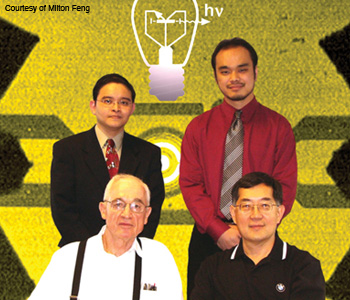Feature
The Metamorphosis of the Transistor into a Laser
The transistor put us on the path to semiconductor electronics research. It led to the integrated circuit, optoelectronics, light-detecting devices, diode lasers, LEDs, and now further to the transistor laser—a true laser and three-terminal photonic transistor active element.
 (Counter clockwise from bottom left) Nick Holonyak Jr., Milton Feng, Gabriel Walter and Richard Chan. A light-emitting transistor is shown in the background. The bullseye white ring is the quantum-well base recombination light visible from the top with a small Bragg reflector buried in the transistor collector.
(Counter clockwise from bottom left) Nick Holonyak Jr., Milton Feng, Gabriel Walter and Richard Chan. A light-emitting transistor is shown in the background. The bullseye white ring is the quantum-well base recombination light visible from the top with a small Bragg reflector buried in the transistor collector.
Arguably the most important transistor ever made was the Bardeen and Brattain point-contact transistor, which came in 1947. It was the original bipolar semiconductor triode (i.e., +/– charge conduction, the positive hole as important as the negative electron). It was the device that started it all, the prototype that ultimately doomed the vacuum tube. It led to the integrated circuit and a vast new branch of electronics that made large-scale computers possible.
…Log in or become a member to view the full text of this article.
This article may be available for purchase via the search at Optica Publishing Group.
Optica Members get the full text of Optics & Photonics News, plus a variety of other member benefits.
